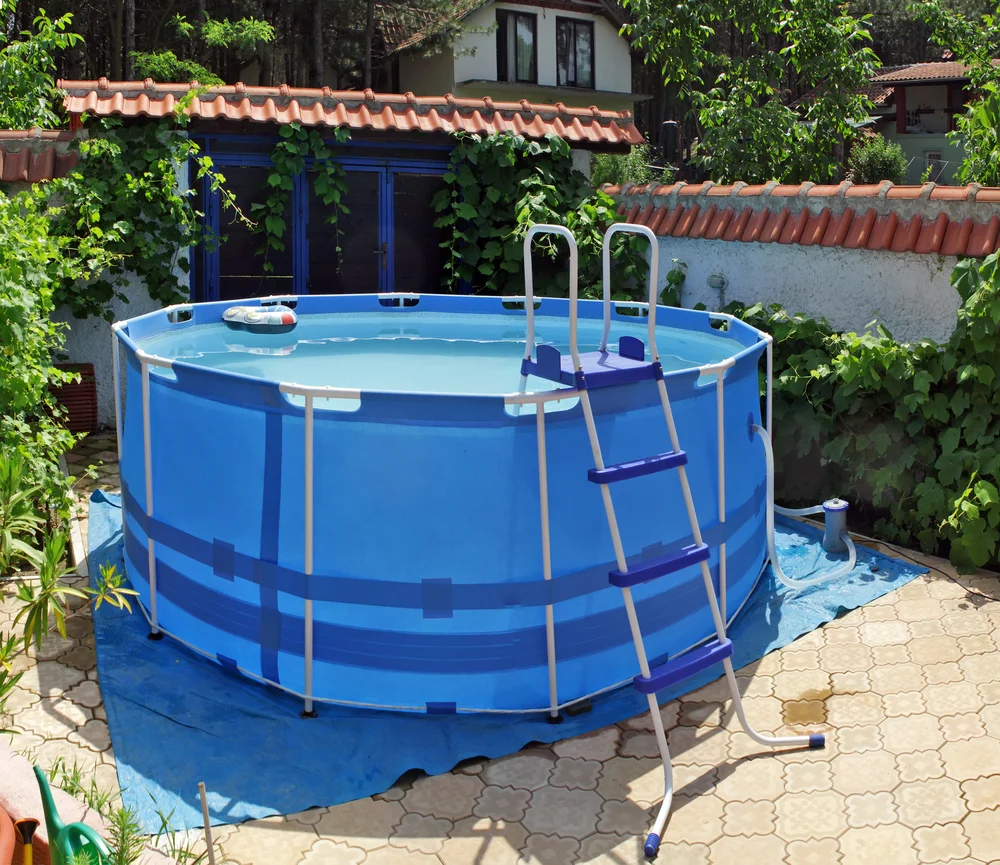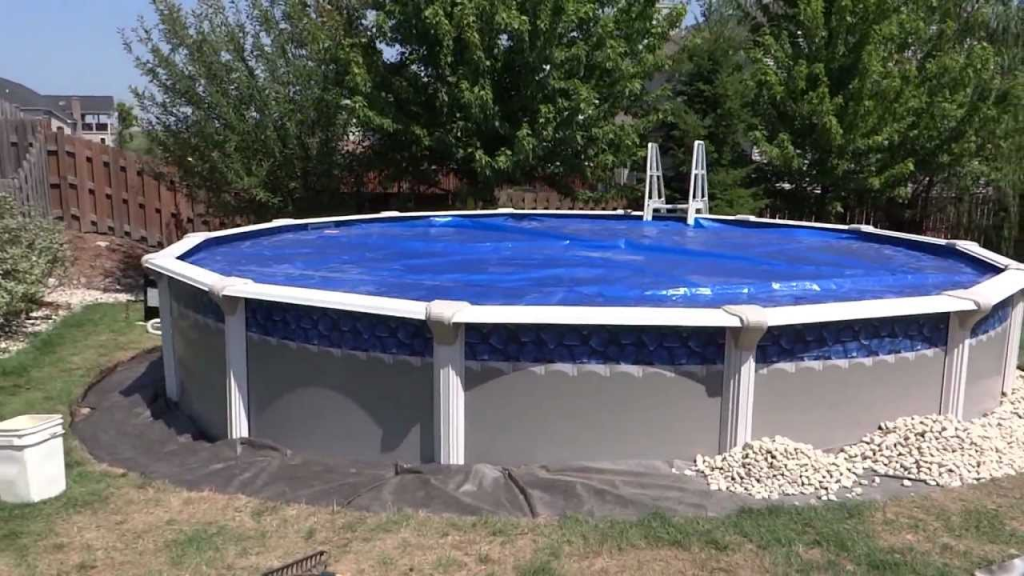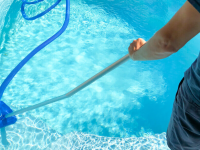Nowadays, there is no problem with what to put under an above-ground pool, as there are many different options of liners on the market. They are easy to install, protect the bottom from damage and last a long time.
Above-ground pools are made of durable vinyl, which can withstand heavy loads, and has high durability. But such a coating can easily be damaged by an ordinary stick, stone, rebar, or glass. For this reason, manufacturers of above-ground pools recommend laying underlayment and building catwalks and cement bases before installation on the surface. We wrote how to make a cement base in our article — how to build a base for a hot tub. And now, we tell in detail what to put under an above-ground pool.
How to choose what to put under above-ground pools
The substrate and the base under the frame pool perform crucial functions:
- Cushioning the bottom, helping to reduce its wear and tear.
- Insulation that retains the heat of the water.
- Cutting off the bottom material from contact with the soil, moisture, and minor irregularities.
The substrate or base under the pool must be strong and be able to withstand heavy loads. The substrate should be laid in an even layer on a level surface: no bulges, debris, tree roots, or anything else. Foreign objects can damage it, and if heavily loaded, they can puncture the bottom of the pool.
📌You should not use fabrics made of natural materials that can absorb moisture and rot. Such substrates not only fail to perform their tasks but also harm the bottom material and destroy the site.
Experts recommend choosing a substrate that is larger than the pool frame. After taking water procedures, you will be able to go out to a dry and clean area and leave things on it.
Below we will look at these options in more detail:
| Options | Best for |
| Concrete Slab | Suitable for those who want to do everything once — reliably and permanently. This option requires an initial time commitment, but then it will serve for years and does not require any investments and actions with it. |
| Sand | It is a simpler and more affordable option than a concrete slab. It is suitable for those who want to install the pool themselves and save a little money. But the sand will need to be periodically corrected. |
| Pre-Cut Pool Pad | This option is for those who want to save time but not money. These liners are sold pre-made in size and just need to be placed under an above-ground pool. |
| Flooring Underlayment | It is suitable as a temporary option, provided that you have a flat area under the pool. |
| Interlocking Foam Tiles | This option is also suitable for people who want to make substrates on their own. It’s easy to lay and affordable. But, over time, this material can wear out. |
| Carpet Padding | Such a liner is best used only as a last resort when you badly want to swim and have no other options, but not for long. |
| Natural Ground | We do not recommend anyone to put an above-ground pool on bare ground — that way, the pool will quickly fall into disrepair. |
What to put under above-ground pools?
Each of the substrates below has its pros and cons, which play a significant role when choosing a foundation for your pool. Experts recommend giving preference to full-fledged cement bases. But other options also have a place if you do not want to spend time preparing the site for the full-fledged base installation: remove the top layer of soil, level the area, lay several layers of different materials, construct a frame, and so on. Ready-made solutions significantly save time, effort, and money.
Choosing what to put under the surface pool, you should consider how easy it is to work with the material and how much it costs.
Concrete Slab

For above-ground pools, the base of the cement — is a reliable and durable solution that can solve the problem of what to put under the artificial pond for many years.
Cement is suitable when the pool and platform are not going to be removed for an extended period. In this case, the cement is used not as an independent material but as part of the podium structure.
A substrate should be placed between the cement and the pool. Below we provide information on what options to put under an above-ground pool on concrete.
Pros
- High strength and reliability.
- Durability provided the use of quality materials and compliance with manufacturing technology.
- Resistant to high humidity and temperature extremes.
- Wear resistance.
- Affordable cost.
Cons
- The difficulty of installation.
- Concrete is dusty if you do not cover it with finishing materials.
- The risk of deformation of the coating in severe frosts.
- Solidification and hardening of concrete will require at least 20 days.
- Not very aesthetically pleasing.
- If cracks appear, it is impossible to repair — you will have to replace the layer completely
Sand

It is a simple and accessible material from which you can make a base for the pool by yourself.
For such a substrate to be as effective as possible, it is necessary to remove some soil from the installation site of the structure and fill it with sand. The finished substrate is moistened with water and tamped.
Compared to concrete slabs, the sand will eventually wear out and erode during heavy rain. Also, animals can dig in it and create holes.
Pros
- Availability.
- Low cost.
- Ease of execution.
Cons
- Short-lived (the sand is washed away by rain, and pits appear).
- Hard physical costs when doing the work.
Pre-Cut Pool Pad

Pool pads are made of geotextile, a moisture-proof, durable material specifically designed to cushion and protect the bottom of an above-ground pool.
Typically, the laying of geotextile is performed on a prepared base. Pads are easy to install because they are sold pre-cut in standard sizes. The only thing is that they are one of the most expensive options on this list.
Pros
- Durability (not affected by chemicals, not destroyed).
- Strength.
- Moisture resistance.
- Sold in ready-made sizes.
Cons
- Relatively high price.
- Loss of quality when directly exposed to sunlight.
Flooring Underlayment

Flooring underlayment is not usually used without additional materials as a substrate. It is used to cover a substrate whose moisture protection properties are too low. In the absence of alternatives, polyethylene can only use as a temporary version of the substrate for one season.
Pros
- Low cost.
- Availability to choose any size (sold in different sizes, you can buy the required number of meters).
- Easy installation.
Cons
- Low durability (easily damaged).
- Exposure to sunlight.
- Little compensation for deformations of the substrate.
Interlocking Foam Tiles

Another good option for the substrate under the pool is interlocking foam tiles. They are easy to install, and foam is sold in many hardware stores. Choose non-porous thin options in order so that they don’t absorb moisture.
The foam should be placed on a hard and stable surface. Then you will have smooth and pleasant padding for your feet.
Pros
- It has excellent insulating and reinforcing properties.
- Easily foldable to form a soft, even surface.
- Non-slip, especially comfortable for children’s bathing.
Cons
- It’s hard to cut if the size doesn’t fit.
- Depending on the size, they can be expensive.
Carpet Padding

Many articles have written that carpet can be a good option as a substrate for the pool because it is economical and readily available. But we don’t think it’s a viable option. The fibers of the carpet will always be wet. Because the carpet is hard to dry, it will quickly get moldy and have an unpleasant odor. It is better to choose another of the available options, such as sand.
Pros
- Сheap or even free.
- Readily available.
- Protects from foreign objects.
Cons
- It doesn’t dry out well, so it spoils.
Natural Ground

You can’t just put the pool on the ground. The turf layer under the bottom will begin to rot and sag, creating conditions for the destruction of an above-ground pool. A correctly prepared site will extend the life of the artificial pond.
How to prepare the bottom for an above-ground pool?

First of all, it is necessary to choose a suitable location for the pool. The selection should be made according to the distance to the nearest source of water supply, electricity, and sewerage. Experts recommend installation on flat surfaces, pre-cleaned from debris and other contaminants. The absence of trees and bushes near you will spend less time cleaning because leaves, sticks, and fruit will not fall inside the pool.
But if you don’t have the right place to keep the pool clog-free you can choose the best above-ground pool filter pump to simplify the cleaning process and spend less time on it and more time enjoying swimming in a spotless pool.
Preparation of the area is carried out in several stages:
- Location selection, removal of all foreign objects.
- Marking the shape of the bottom, removing the layer of turf.
- About 15-20 cm deep, remove the top fertile layer of soil.
- Thoroughly level the surface, and check the level by the construction level.
Installation Tips

Maybe you want to know what to put under the pool, which stands on the grass, concrete, or gravel. We have also looked into this question.
What to put under an above-ground pool on grass?
If you do not want to remove the top layer of soil, you will need to treat the grass with herbicide before installing an above-ground pool (provided the ground surface is level). After that, you can lay any option that suits you:
- Pre-cut pool pad
- Flooring underlayment
- Interlocking foam tiles
What to put under an above-ground pool on concrete?
Above we wrote that there should be an additional layer — a substrate between a concrete base and the bottom of the pool. It prevents the bottom of the pool from rubbing off and wearing out.
You can put interlocking foam tiles or a pre-cut pad on the concrete so it won’t get dusty, and your feet will feel soft. Also, children won’t get hurt if they fall on the foam tiles.
What to put under an above-ground pool on rocks/gravel?

Do not put rocks and gravel under an above-ground pool — otherwise, it will damage the bottom. It is better to choose reliable and durable concrete or a cheaper option with easier installation — sand. Gravel can be placed around the perimeter of the pool to serve as drainage to avoid puddles.
Summary
Now you know what options are available and what is better to put under an above-ground pool in your case.
When installing an above-ground pool, the substrate is a vital part of the entire structure. Without a well-prepared base, a pool bottom will quickly fall into disrepair and will not be comfortable to use. Therefore, it is significant to take this issue seriously and choose the best option.
The substrate or base under the pool must be strong and be able to withstand heavy loads. The substrate should be laid in an even layer on a level surface: no bulges, debris, tree roots, or anything else. Foreign objects can damage it, and if heavily loaded, they can puncture the bottom of the pool.
FAQ
🧐What is the best thing to put underneath an above-ground pool?
The best option for installing the pool is a concrete base with an additional substrate, so the bottom of the pond will not wear out. This option is labor-intensive but the most reliable and durable, so the pool will work for you for 10-15 years. As the substrate suitable are interlocking foam tiles, they are soft and pleasant to feel on the feet. And they are also easy to install.
🏡How to prepare the bottom for an above-ground pool?
Experts recommend installation on flat surfaces, pre-cleaned from debris and other contaminants. Area preparation is carried out in several stages:
🌊Do you need a mat under an above-ground pool?
The pool bottom can easily be damaged by an ordinary stick, stone, rebar, or glass. For your above-ground pool to serve you for a long time, it is necessary to put under it a substrate. It can be concrete, sand, a pre-cut pool pad, flooring underlayment, or interlocking foam tiles.
🌀Should you use a liner pad for an above-ground pool?
We recommend using interlocking foam tiles. They are easy to install, and foam is sold in many hardware stores. Choose non-porous thin options so they don’t absorb moisture and the ground under the slabs does not rot. Also, foam tiles have excellent insulating and reinforcing properties.





I like how you mentioned that the entire pool structure could be enhanced by using a concrete base. My best friend told me yesterday that he was planning to have a swimming pool that could last for many years. He asked if I had ideas on the best pool rebar installation approach. Thank you for this instructive pool guide article, I’ll be sure to tell him that it will be much better if we consult a trusted pool rebar installation company as they can provide more information about the process.